7.6: Feminist Art (1970-2000)
- Page ID
- 120773
Introduction
Feminism is a French word, feminisme, and labeled the concept of social and political movements with ideologies for women's equality. Feminisme moved rapidly from Europe to the United States in the early 20th century and became synonymous with the Women's Movement. It means woman (femme) and a social movement (isme) and implied social change for women, culminating with their right to vote in 1920. The "women's movement," referred to in the United States, had a critical turning point in the 1960s when it expanded into women's liberation. This second wave of feminism was directly related to the "capitalist economies which had drawn millions of women into the paid labor force, and civil rights and anti-colonial movements had revived the politics of democratization."[1] The advent of the Feminist movement incited a wave of core female issues such as reproductive rights, equal rights, sexism, and gender roles through art activism. The 1970s conscious raising challenged the status quo, demanding the art world to change the inequality of art.
Feminist art challenges the domination of male artists to gain recognition and equality for women artists. (MOMA)
The Women Who Defined Feminist Art
From the 1970s onward, women were expected to raise their children and work, while men only had to earn a living. The women's liberation movement demanded political and economic rights and expanded women's equality to equal pay for an equal job, equal help in the household, and equal opportunity. Along with the second wave of feminism, women are in the public arena remained marginal, and in the New York Whitney Museum, only 5% of the artists were female.[2] Judy Chicago and Miriam Schapiro created a project called the Womanhouse at the California Institute of the Arts. The project consisted of 17 rooms of visual representations of gender-stereotyped relationships.
Feminist artists began to explore women's spaces, using metaphors to create large installations like The Dinner Party by Judy Chicago. Chicago's installation created a large triangle table with genital imagery on the ceramic plates celebrating famous women in history. In the last 30 years, feminism has created opportunities for female artists regardless of if they are feminists or not (Freedman, 2000). The famous art historian Linda Nochlin published the influential "Why have there been no great female artists?"[3]
"The fault, dear brothers, lies not in our stars, our hormones, our menstrual cycles, or our empty internal spaces, but in our institutions and our education—education understood to include everything that happens to us from the moment we enter this world of meaningful symbols, signs, and signals. The miracle is, in fact, that given the overwhelming odds against women, or blacks, so many of both have managed to achieve so much sheer excellence in hose bailiwicks of white masculine prerogative like science, politics, or the arts."[4]
The Guerrilla Girls were an American group of women activists exposing the domination of white male artists in the art world. Their mission was to elevate women artists and artists of color in the 1980s when a New York Museum exhibited an international painting and sculpture. Only 13 women out of 169 artists were in the exhibit. This disparity became the mantra (7.6.1) to eradicate sexism and racism in the art world.
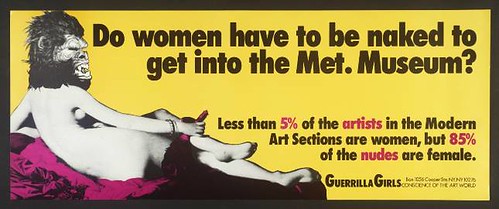
From the perspective of women's issues, the next two decades began significant social changes, most of them toward greater freedom and opportunity. The Sixties saw the upheavals of sex, drugs, rock and roll—and approval of the first oral contraceptive. The Seventies ushered in "women's lib," women's "consciousness-raising," "no-fault" divorce, and Title IX, the provision of equal funding for women's sports. The Feminist Art Movement set out to connect the founding pillars of contemporary art and women. In its wake, the movement motivated for change, redesigned social attitudes, and improved gender stereotypes in the arts for the better.
Judy Chicago
Judy Chicago (1939-) is an American feminist artist well known for her large collaborative art installation called The Dinner Party. Chicago attended UCLA Art School and quickly became politically active, graduating with a master's in fine arts in 1964. She taught full-time at Fresno State College, teaching women how to express themselves in their artwork. It transformed into a Feminist Art Program and was widely popular with women. Judy Chicago and Miriam Schapiro created a project called the Womanhouse at the California Institute of the Arts, transformed an old house, and created different artistic representations of women's domestic work.
Feminist artists began to explore women's spaces, using metaphors to create large installations like The Dinner Party (7.6.2). Chicago's installation depicted a large triangle table with genital imagery on the ceramic plates celebrating famous women in history. The entire project took five years due to the large size, 14.6 by 13.1 by 10.9 meters, with 39 different place settings. An embroidered table runner corresponds to the female figure plate and is set with silverware and a goblet. The inspiration for the Dinner Party was devised during a male-dominated dinner party Chicago attended. She felt women needed to be recognized at the table as well since they are mostly overlooked. The 39 plates represent historical or mythical female figures set like the Last Supper with 13 people on each side of the triangle. Another notable 999 women's names are inscribed in gold on the exhibit floor. The meeting of 39 females was a powerful statement popular with the public; however, it was disparaged by the critics who called it "vaginas on plates."
"The Dinner Party's positive celebration of female bodies and sexuality, its consciousness-raising about women's history and reclamation of women artists, and its subversion and revision of masculinist historical narratives, was an enormous popular success."[5]
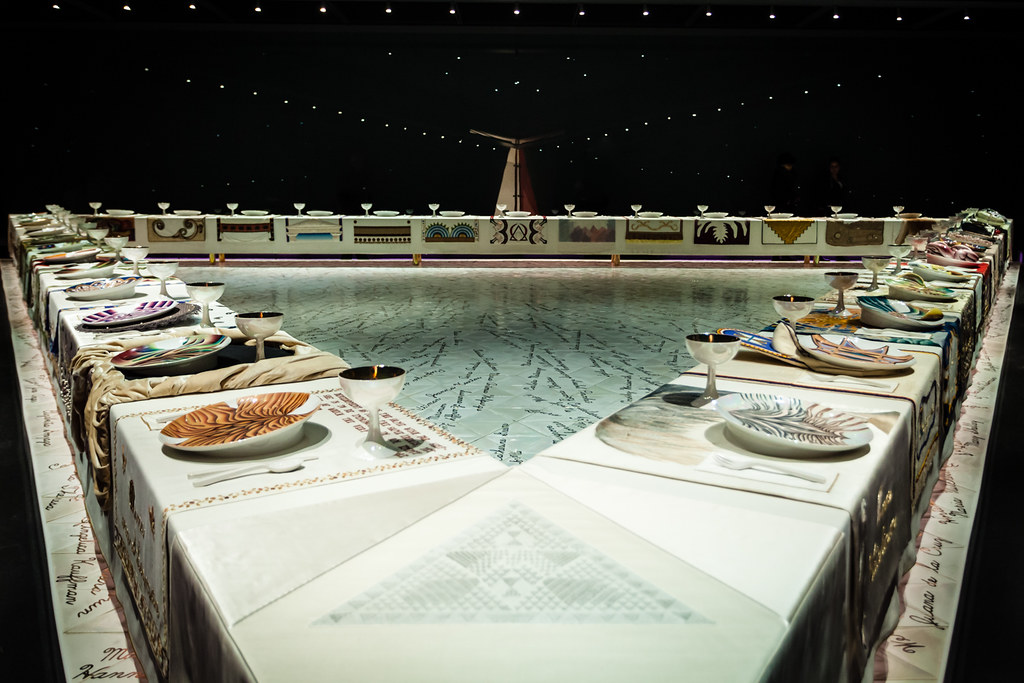
Chicago's etched painting Fused Mary Queen of Scots (7.6.3) is a unique blend of fusing, etching, and kiln-fired spray paint that took over a year and a half to develop. Studying stained glass, she came across the Chinese art of painting on glass in sophisticated colors that replicated the look of porcelain. The piece is a mix of yellow and blue radiating spiral lines surrounded by a light purple frame with handwritten words. Mary Queen of Scots was an ambitious woman and held the title of Queen of Scotland, a title she acquired at six days old after her father died. She was found guilty of a plot to kill Queen Elizabeth and was beheaded shortly afterward, generating a divisive and highly romanticist historical character from the 16th century. The work brought ceramics forward from a craft to fine art using technical skills.

The Birth Project was a conglomerate of artwork designed by Chicago and completed by needleworkers artists around the United States, Canada, and other localized places in the world. Needlework has always been considered women's work, a craft beneath most artists. Chicago led the collaborative project about women who created life and experienced childbirth from many points of view. The process of childbirth was not generally a subject brought up at parties or discussed at the dinner table, yet she brought the issue upfront and personally. "Through my art, this is a subject worth confronting, a subject rich in meaning and insignificance for women's lives, and—because women are over half the population, because everyone is born, and because children have to be raised—a subject worthy of attention of the entire human race" Judy Chicago, Birth Project, Doubleday, 1985. Birth Tear Embroidery 3 (7.6.4) is a drawing with a sharpie of a woman during childbirth on a piece of pink silk later embroidered. The predominant color of red represents the tear during the birthing process, which fades out to purple and blue. The image also displays the pain of the woman during birth.
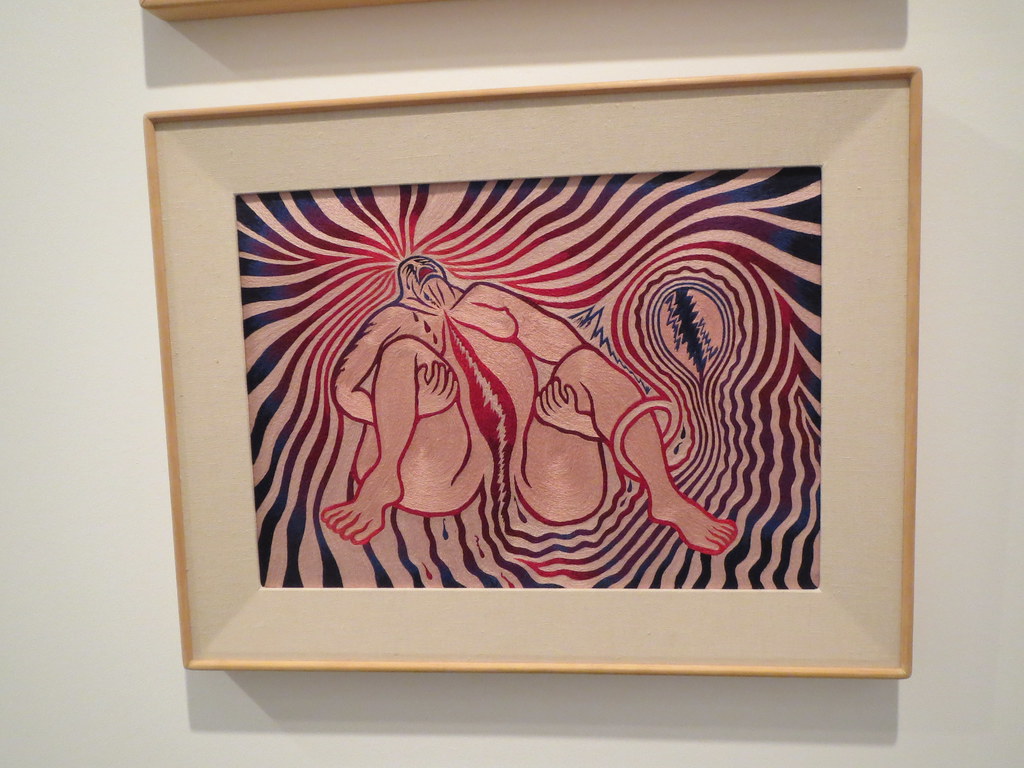
Barbara Kruger
Barbara Kruger (1945-) is an American Feminist Artist who produced black and white photographs with declarative captions in red and white. She is a Distinguished Professor at the UCLA School of the Arts and Architecture. Kruger creates large-scale digital installations combining photography and collage. "Overlaid with provocative graphics on authority, identity, and sexuality, her work confronts the power of mass media."[6] The silkscreen painting, Untitled (Your Body is a Battleground) (7.6.5), was originally a poster for a 1989 pro-choice march in Washington D.C. The poster depicts the artist's opinion about gender inequality. The black and white photographs are images of women from the 1950s contrasted with bold white text on red backgrounds. Focusing on the heated topic of reproductive rights, the text begins with 'Your' signaling the unification of women around America, telling the patriarchal society about the feminist struggle. Unfortunately, art from the 1970s is still a battleground in the 21st century.
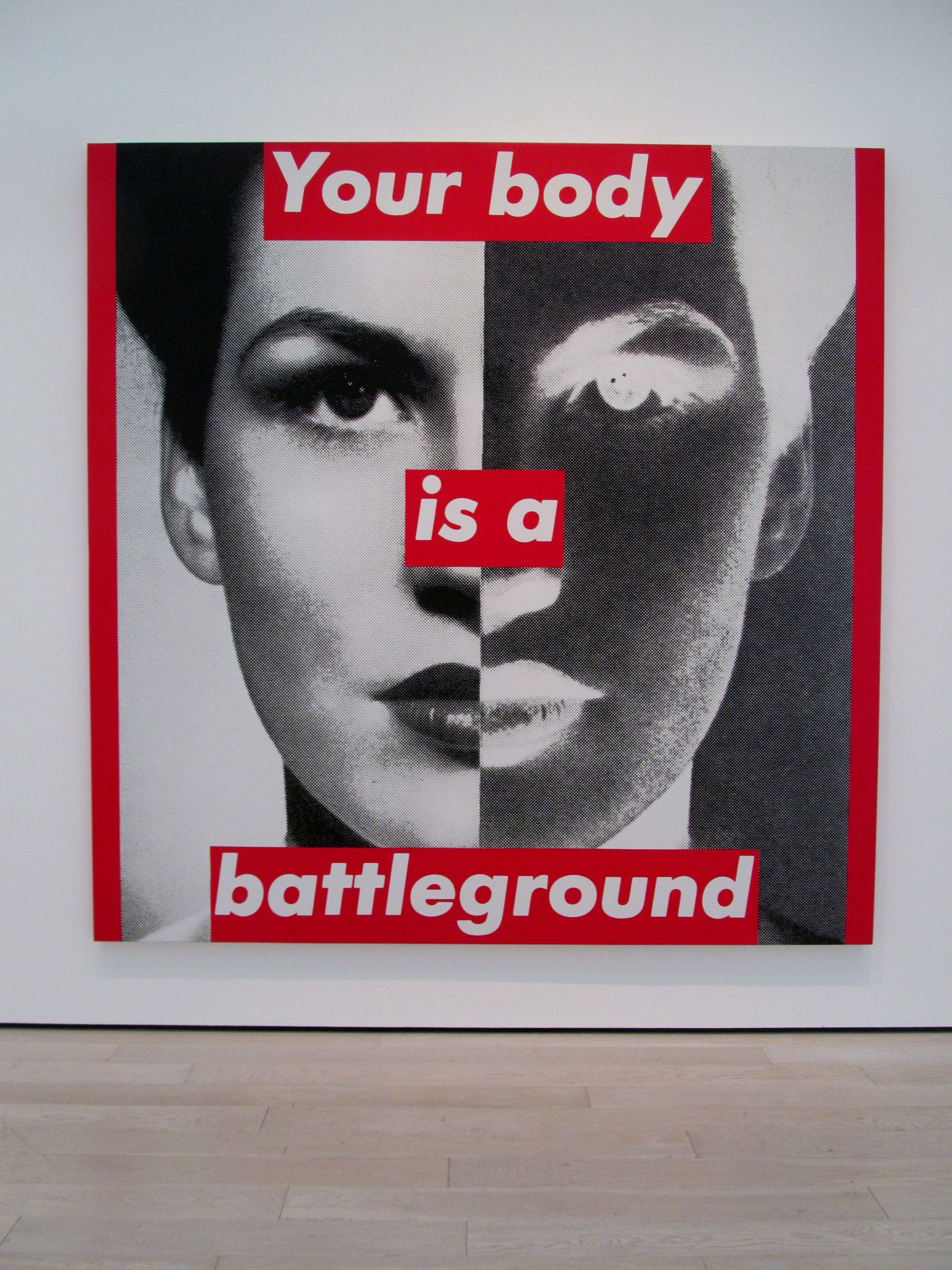
Over the next two decades, Kruger focused on installations that immersed the viewer into the art. Belief+Doubt (7.6.6) fills the museum's lower level with a bold color scheme of black and white with splashes of red for emphasis. She focused on the themes of democracy, money, power, and belief, filling the entire space with text-printed vinyl immersing viewers into a world of text they must read, introducing doubt through questions. Kruger's visual communication began in her early career as a designer, and it carried on throughout her work for decades. The language of pop culture in magazines utilizes brief short sentences to convey messages and Kruger used the persuasive power of pop culture's images in her art.
.jpg?revision=1)
Kruger became famous for her aphoristic declarations of feminist principles married with large photomontages. Untitled (Now You See Us) (7.6.7) is a change from the black, white, and red art and includes a deep lemon yellow in place of the white. The yellow represents a lightbulb glowing bright yellow against a dark grey background. The direct yellow words are still against a red background in large font, while the second declaration is small, on the bottom, and red against a dark grey background.
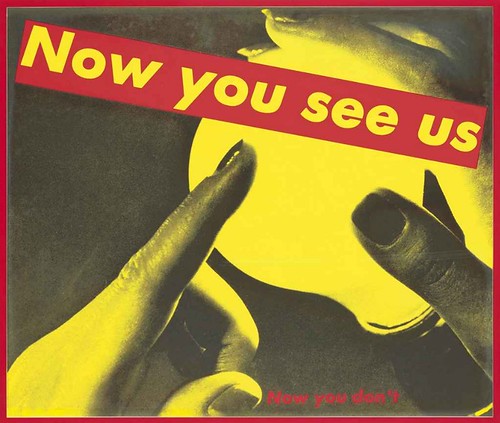 Figure \(\PageIndex{7}\): Untitled (Now You See Us) (1984, gelatin silver print, 181.6 x 105.4 cm) by Cea, CC BY 2.0
Figure \(\PageIndex{7}\): Untitled (Now You See Us) (1984, gelatin silver print, 181.6 x 105.4 cm) by Cea, CC BY 2.0Carolee Schneemann
Carolee Schneemann (1939-2019) was an American visual experimental artist who received an MFA degree from the University of Illinois. She began her career as an Abstract Expressionist painter but became disillusioned by the misogynistic heroism painters in New York City. Turning to artistic performance art, Schneemann became involved with feminist art and the exploration of the female body. A stage backdrop, Four Fur Cutting Boards (7.6.8), is an extension into time and space as a moving sculpture that viewers in the room can activate. The name of the artwork is from Schneemann's art studio, which was an old fur shop in Manhattan. The art is a conglomerate of oil paint, umbrellas, motors, lightbulbs, string lights, photographs, fabric, lace, hubcaps, printed papers, mirror, nylon stockings, nails, hinges, and staples on wood.[7] Schneemann painted her nude body and photographed herself interacting with the art becoming the subject and the object. Feminist art presents the female artist influenced by feminism—a double knowledge—of the female body.

As technology exploded, Schneemann experimented with laser printers creating painted prints of vulva images, part of the female genitalia. Vulva's Morphia (7.6.9) is a set of thirty-six pieces of art displayed in a clear plexiglass display. The in-your-face up-front rudeness of the imagery is balanced by a bitterly ironic text: "Vulva recognizes the symbols and names on graffiti under the railroad: slit, snatch, enchilada, beaver, muff, coozie, fish and finger pie . . . Vulva deciphers Lacan and Baudrillard and discovers she is only a sign, a signification of the void, of absence, of what is not male . . . (she is given a pen for taking notes)".[8]
A visual grid with text, Vulva's Morphia are depictions of vulvas from an artist's point of view. The surrounding text is statements such as "Vulva decodes feminist constructivist semiotics and realizes she has no authentic feelings at all; even her erotic sensations are constructed by patriarchal projects, impositions, and conditioning." [9] Schneemann is taking back the female body and endorsing its powers without limits. For decades, she created art that challenged boundaries, attacked societal taboos, and kept it in our faces to ensure we do not forget.
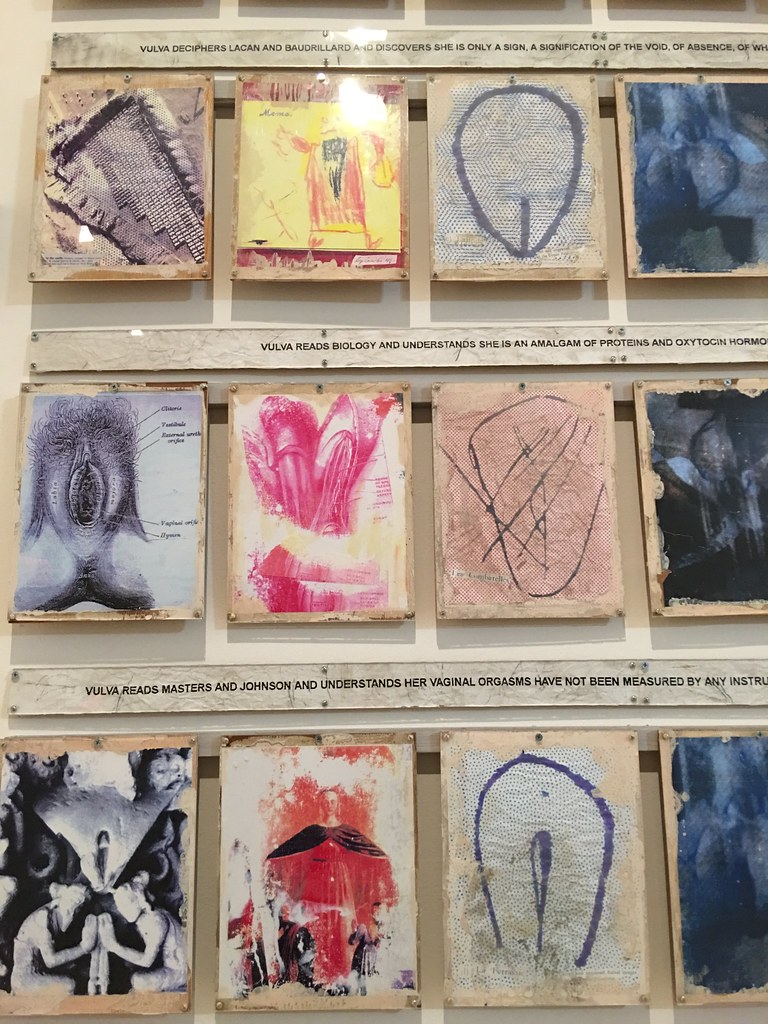
Jenny Holzer
Jenny Holzer (1950-) is an American neo-conceptual artist known for her text installations. A graduate of Rhode Island School of Design, she moved to New York City in the late 1970s, exploring social and cultural theory. Holzer began her art career with Truisms, public works offering simple statements Holzer printed out on paper and wheat-pasted to buildings. The list of words came from her philosophy and literature classes; she condensed the entire text into a sentence. Moving from paper, Holzer turned to LED signs to flash her text on buildings or billboards. Stave (7.6.10) presents an LED sign in seven curved double-sided text with red and blue diodes stating, "Would Like to Go Back Home." The delivery of words in large-scale installations earned her a spot in the famous The Times Square Show.

A political activist, Holzer was looking to disrupt the passive information from sources that could be more damaging than helpful. In her Living Series, Protect Me From What I Want (7.6.11), are statements printed on stone, bronze, and aluminum plaques and placed on government buildings around New York City. These one-liner quotes were from a reading list while Holzer was a student. The short statements were about everyday necessities of life like breathing, sleeping, eating, and relationships. The messages represent the beginning of the information age and the jump start of social media.

During the early 1980s, Holzer created a body of work called Inflammatory Essays (7.6.12), consisting of posters influenced by political figures. Some of the excerpts read: "Rejoice! Our times are intolerable; Take courage, for the worst is a harbinger of the best; Only dire circumstance can precipitate the overthrow of oppressors; The old & corrupt must be laid to waste before the just can triumph; Contradiction will be heightened; The reckoning will be hastened by the staging of seed disturbances, and The apocalypse will blossom."[10] The posters have been recreated on colored paper and attached to the walls in lines of color for impact.
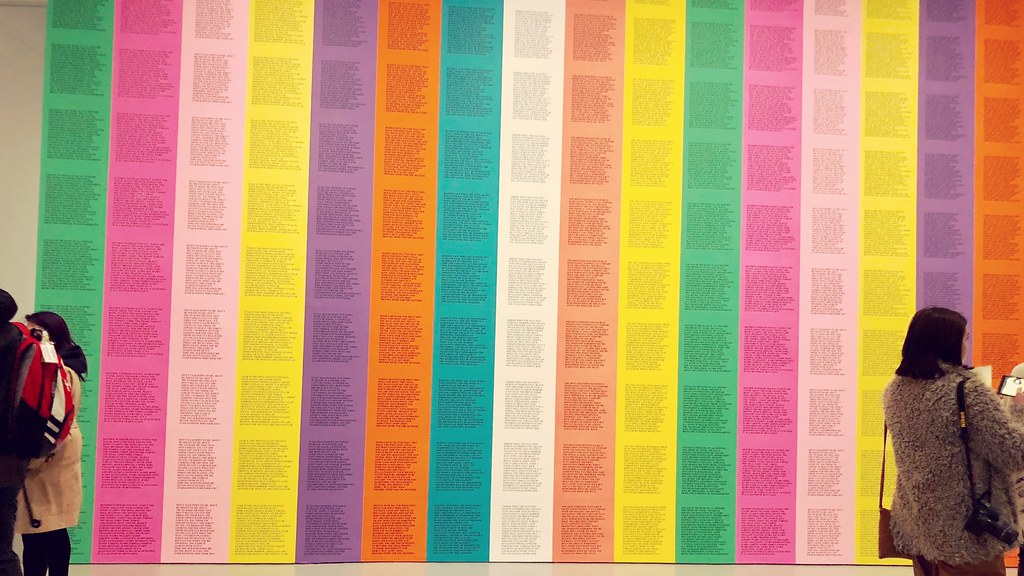
Faith Ringgold
Faith Ringgold (1930-) is an American artist born in Harlem during the Great Depression. Her parents were descendants of the Great Migration (the movement of six million African Americans from the rural south to the northeast, midwest, and west coast to escape the south's Jim Crow Laws). Ringgold's mother was a fashion designer, and her father was an avid storyteller. Ringgold inherited both qualities from her parents, and they are the driving force in her artwork. She was also influenced by the Harlem Renaissance, a cultural art revival of African American dance, music, and politics in Harlem, a predominantly African American neighborhood.
Ringgold began her painting career after graduating from art school, inspired by Pop Art, African art, Cubism, and Impressionism. Exploring self-portraits, she addresses some of the concurrent Black Power movements in the 1960s. Early Works #25: Self Portrait (7.6.13) is an oil painting on canvas in a tight red circle outlined in white. Circles dominate the portrait behind Ringgold, the string of pearls and the two circles on her chest. Her arms are folded across her waist, and she is wearing a multicolored blue dress with a very determined gaze on her face. Ringgold comments, "I was trying to find my voice, talking to myself through my art."[11] In the 1970s, Faith Ringgold collaborated with her mother, Willi Posey, a well-known tailor in Harlem, to make several textiles works.
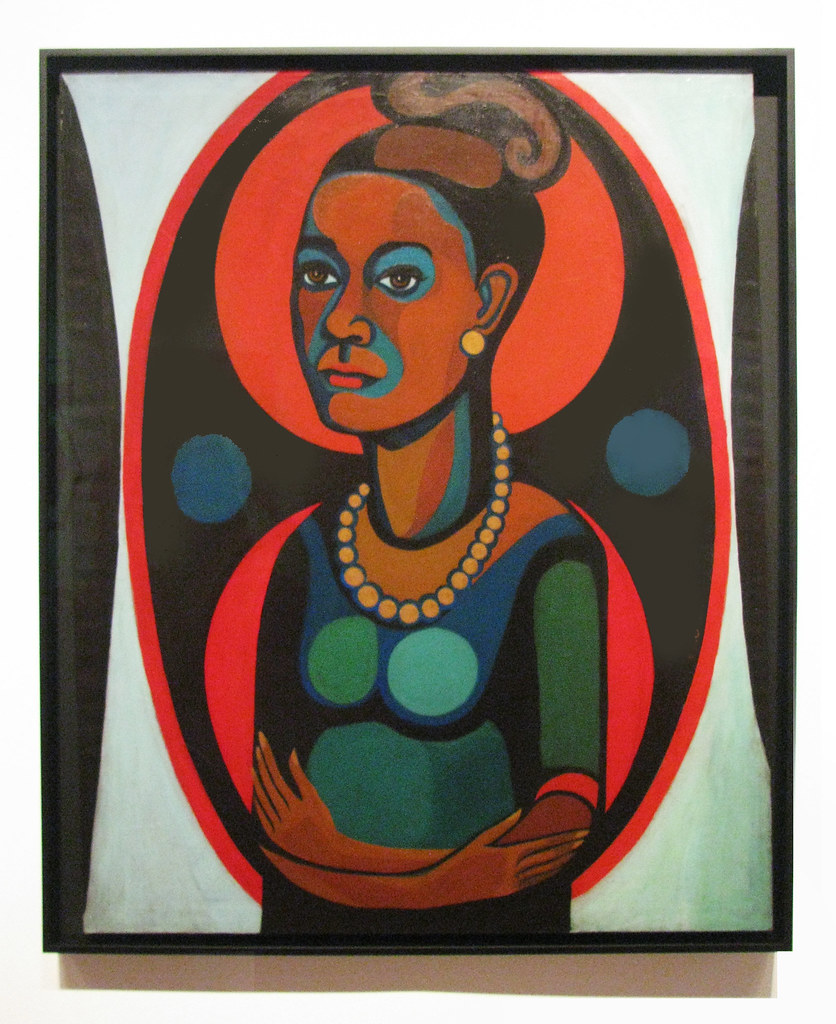
Echoes of Harlem (7.6.14) was Ringgold's first quilt and her final collaborative project with her mother. The composition unifies four different fabrics in a recurring rhythm and frames thirty faces, displaying a variety of individual expressions. Together, the faces represent the many life stories present in Harlem. In subsequent years Ringgold began constructing narrative quilts that portray different aspects of African American life in the United States.
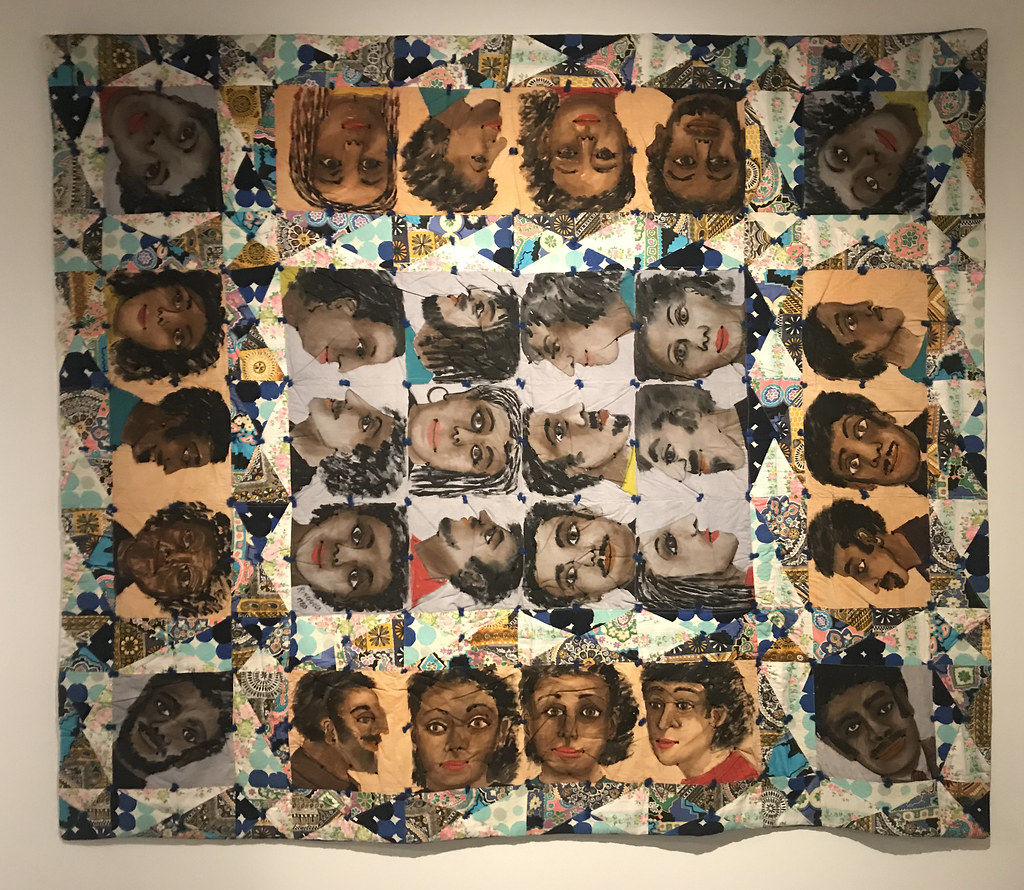
Ringgold and other black women artists pursued a black cultural consciousness grounded in the reclamation of black historical memory and pan-African spirituality.[12] Framing the issues from black female identity, Ringgold created art inspired by trips to Africa, creating crafts stitching together unique storytelling quilts. One of Ringgold's most famous pieces of art is Tar Beach (7.6.15), a painted scene on fabric then quilted the work. The quilt depicts a scene of a family on the roof of their apartment building in Harlem overlooking the George Washington Bridge. The flat roofs on buildings were usually finished in black tar to seal them from the rain and snow. The scene is after dinner, the adults sit around a card table, and the children are lying on blankets wishing they could fly over the city. The story is based upon Ringgold's family memories where "flying among the stars on a hot summer night, Cassie becomes a heroic explorer overcoming obstacles"[13] expresses freedom and self-possession.
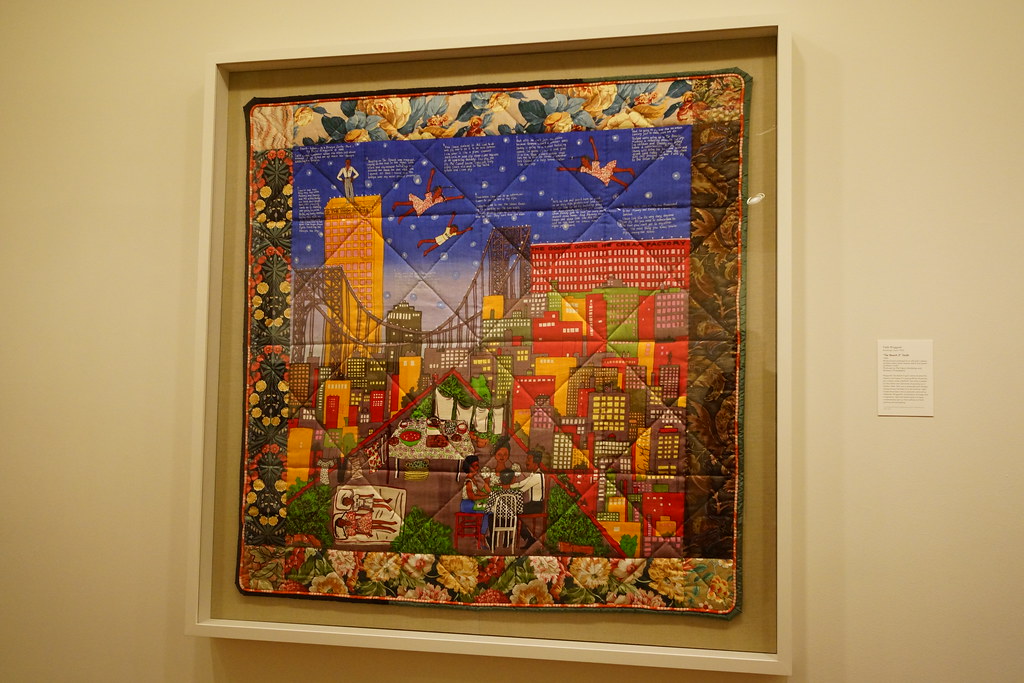 Figure \(\PageIndex{15}\): Tar Beach (1988, acrylic paint, canvas, fabric, ink, thread, 189.5 x 174 cm) by rverc, CC BY 2.0
Figure \(\PageIndex{15}\): Tar Beach (1988, acrylic paint, canvas, fabric, ink, thread, 189.5 x 174 cm) by rverc, CC BY 2.0Tar Beach (7.6.16) closeup depicts the attention to detail with the two children lying on the "tar beach" looking up at the sky. Ringgold is a significant contributor to feminist art and worked with Women Artists in Revolution (WAR), formed in 1969. The group seceded from the male-dominated Art Workers' Coalition (AWC). Ringgold was a professor in the Visual Arts Department at the University of California, San Diego, until 2002 when she retired. Her contribution to art is numerous, as is her publications of books.
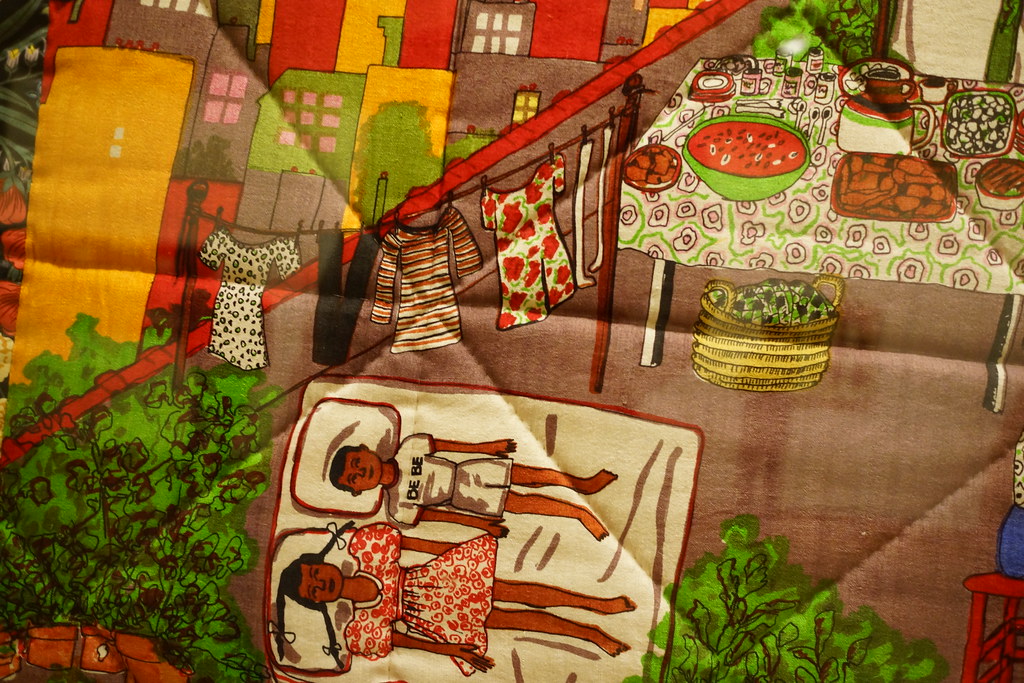
Ana Mendieta
Ana Mendieta (1948-1985) The feminist art movement cultivated the expression of female artists and, by extension, has now given voice to countless previously marginalized female artists of color. The work of Ana Mendieta highlighted ethnic and racial expressions of different cultures. Born in Havana, Cuba, the Mendieta family moved to the United States under Operation Peter Pan during the Cuban Revolution. Completing her MFA from the /University of Iowa, Mendieta moved to New York City to pursue her art career. As a displaced Cuban, Mendieta created art focused on her history of displacement, concentrating on feminism, identity, and belonging themes inspired by the avant-garde community. The elements of nature creep into her art, displaying a spiritual and physical relationship with the earth.
"Through my earth/body sculptures, I become one with the earth…I become an extension of nature, and nature becomes an extension of my body. This obsessive act of reasserting my ties with the earth is really the reactivation of primeval beliefs…[in] an omnipresent female force, the after image of being encompassing within the womb, is a manifestation of my thirst for being".[14]
Mendieta's Silueta Series (Silhouette) continued her fascination with the earth, mud, sand, and grass as her female silhouettes were created in nature and photographed. In Untitled (7.6.17), she created a sculpture with a naked earth-body lying in rock outcrops covered with twigs, weeds, and flowers, connecting with the earth. The contrast between the granite-colored rock, the light brown of the female body, and the green grass with white colors suggest a number of feminist art issues. The significance of a nude woman can exhibit a mother figure, a young woman, or possibly refer to a Mayan deity, lx Chel, which was a feminine life force throughout her work. A key figure in the Body Art Movement, Mendieta combined Land Art into an inextricably linked natural environment art process. Using found objects, she intended to incorporate humanity into one whole world, blurring the boundaries of art movements.
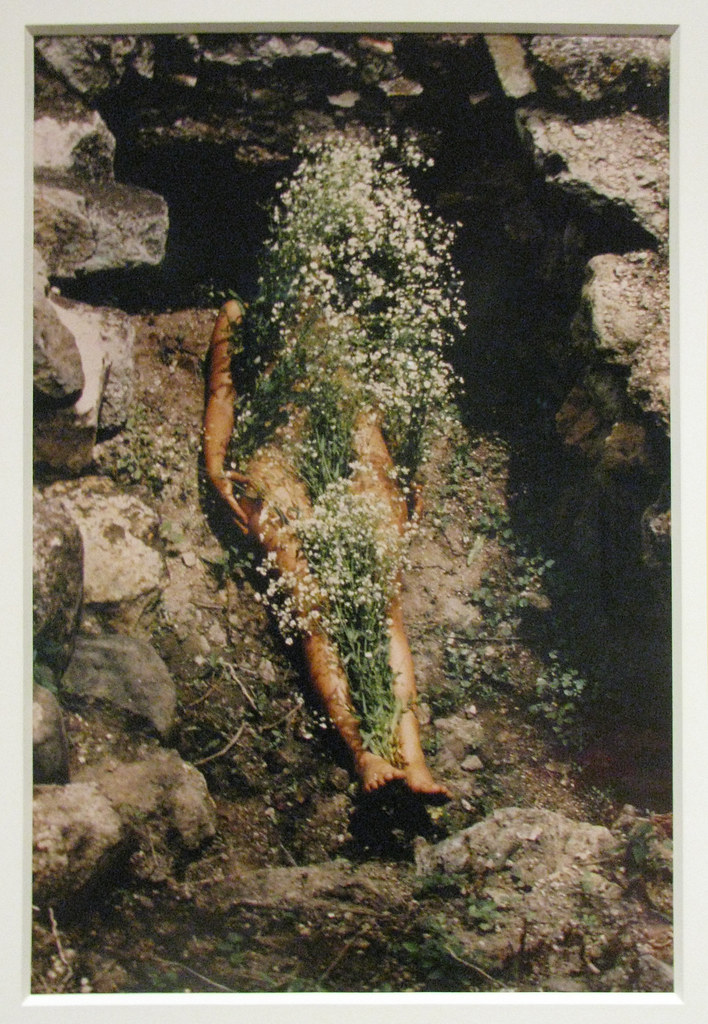
After visiting Pre-Columbian archeology in Mesoamerican areas, Mendieta interpolated the female theme into tombs, earth, and rocks. Craving her figure into the dirt, it was filled with blood, as Silueta Works in Mexico (7.6.18) displays. In the Mayan culture, blood was used as a source of nourishment for all the deities. The ephemeral artworks show just how fragile the human body is when pitted against nature. The earth body sculptures are a powerful depiction of feminist art installations. It is very unfortunate for the art world as we lost Mendieta at an early age. It is unknown if she was pushed or jumped to her death from the 34th floor of her high-rise apartment, and her husband of 8 months was acquitted for any part he may have played in Mendieta's death.
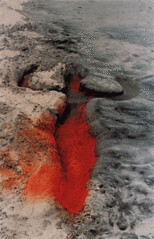
Lorna Simpson
Lorna Simpson (1960-) is an American photographer and multimedia artist from New York and attended the High School of Art in Brooklyn. Simpson traveled to Europe to hone her skills of photography, where she documented people and then graduated from the School of Visual Arts with a BFA in painting. Continuing her education, she received an MFA from the University of California at San Diego, emerging with a style of her own called photo-text—photographs which included text—a pioneer of conceptual photography.
One of Simpson's most famous photo-text works is Five Day Forecast (7.6.19). A bold display of an African American woman with a cropped torso. She wore a white dress contrasting against the rich brown color of her arms folded across her chest. Words are displayed across the top and bottom of the pictures labeled Monday through Friday and ten white words—misdescription, misinformation, misidentify, misdiagnose, misfunction, mistranscribe, misremember, misgauge, misconstrue, and mistranslate—on black rectangles across the bottom of the display. The word mis/miss is an exchange in the power of words and a shower of recriminations.[15]
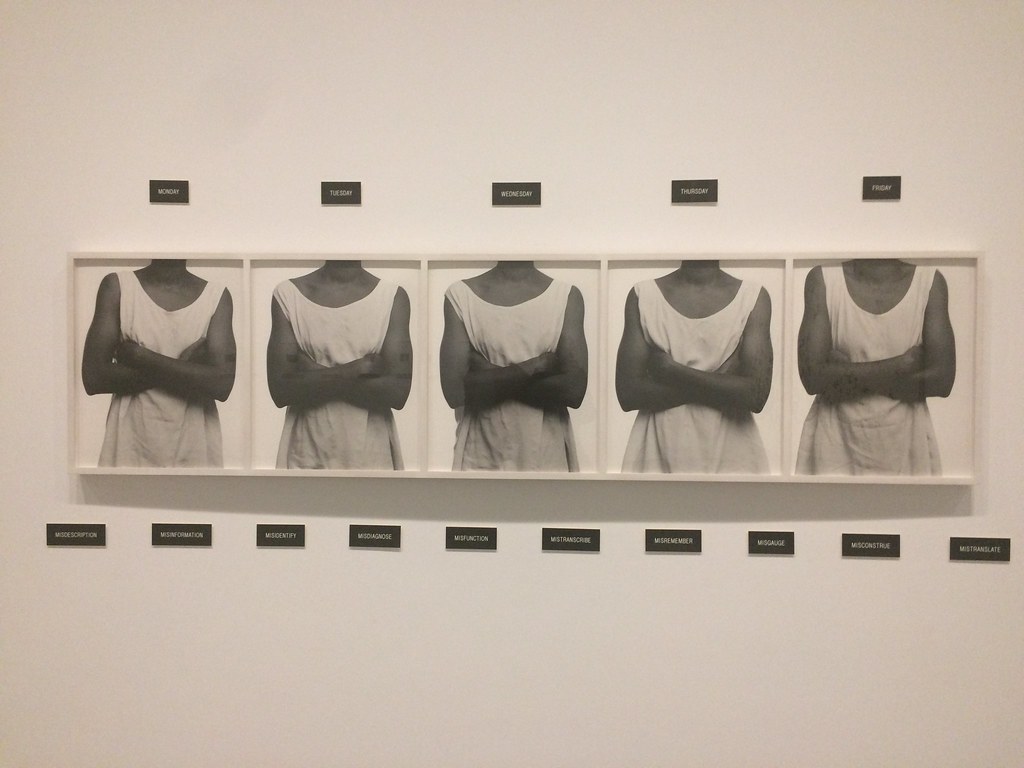
Flipside (7.6.20) pairs the art of an African mask with the art of photography but from the backside of each style. The woman has a black dress and black hair against a black background. The mask is set against a black background, hence the name Flipside. The curves in both photos relate to the popular hairstyle in the early 1960s traditionally worn by African American women. The plaque below reads: The neighbors were suspicious of her hairstyle. The hair and the mask are seen as primitive cultural pieces of art confirming the identity of African Americans as the flipside of a 45-vinyl record, with the topside being the hit of the time and the flipside being the lesser quality.
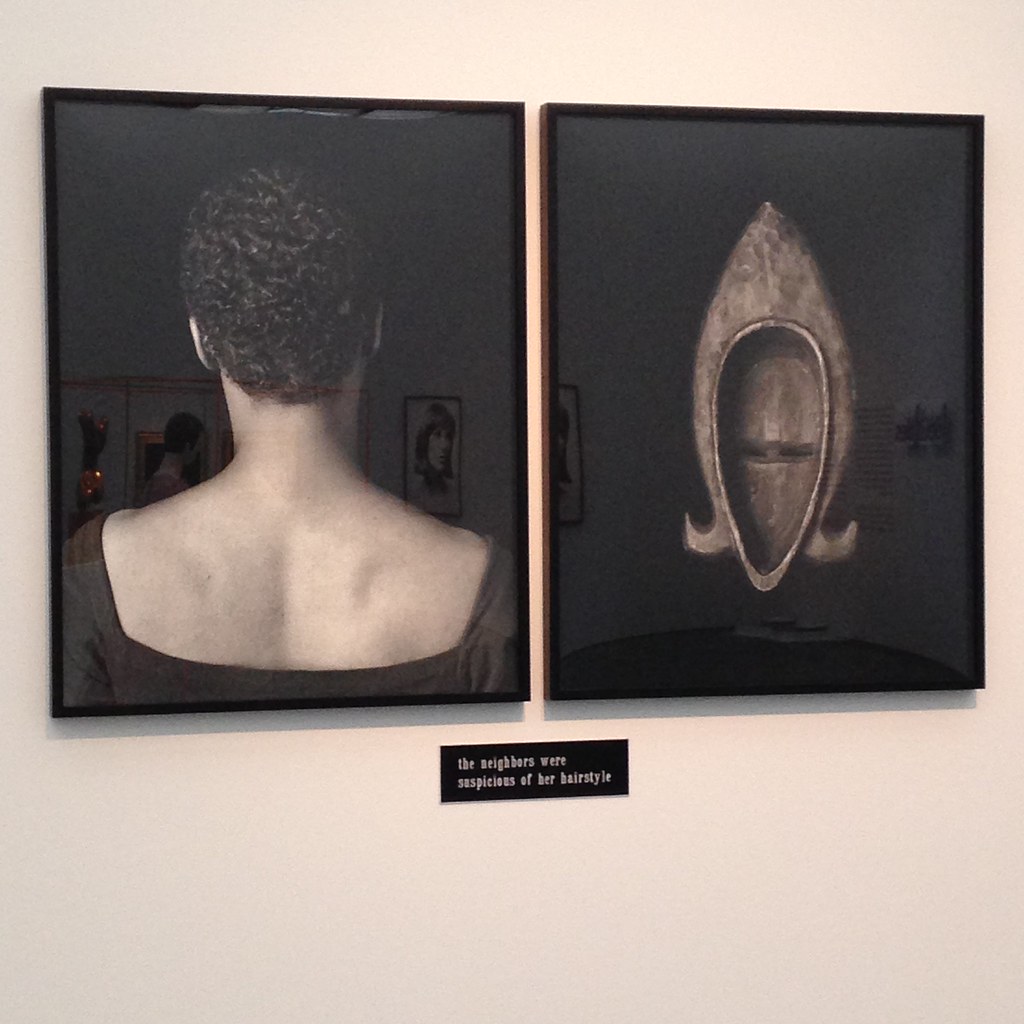
Marlene Dumas
Marlene Dumas (1953-) was born in Cape Town, South Africa, spending her childhood by a river in Western Cape. Dumas attended the University of Cape Town to study art before moving to the Netherlands and transferring to the University of Amsterdam. She majored in psychology instead of art, planning to become an art therapist. Dumas still lives in the Netherlands and is one of the country's most prolific artists. During her life in South Africa, she identified as a white woman of Afrikaans descent and saw first-hand how Apartheid separated white from black people.
Dumas said she does not paint people; instead, she creates an emotional state focusing on race, violence, sex, death, the contrast of guilt or innocence, and even tenderness or shame. She frequently took photographs of friends and used them as reference material along with photos in magazines. Dumas did not paint using live models, only reference material. Her subjects were political, famous, or erotic, mostly controversial. Albino (7.6.21) is one of Dumas' psychologically charged painting with a grey-pink-blue face. The small red-brown eyes are set on each side of a large wide nose with full lips and a small chin. The large forehead is swathed in white light with a widow's peak at the hairline and painted with spontaneous brushwork. By choosing a subject whose very existence complicates the notion of racial categorization and by rendering his skin tone and hair color in a sickly green hue, Dumas insisted on destabilizing the division between black and white.[16]
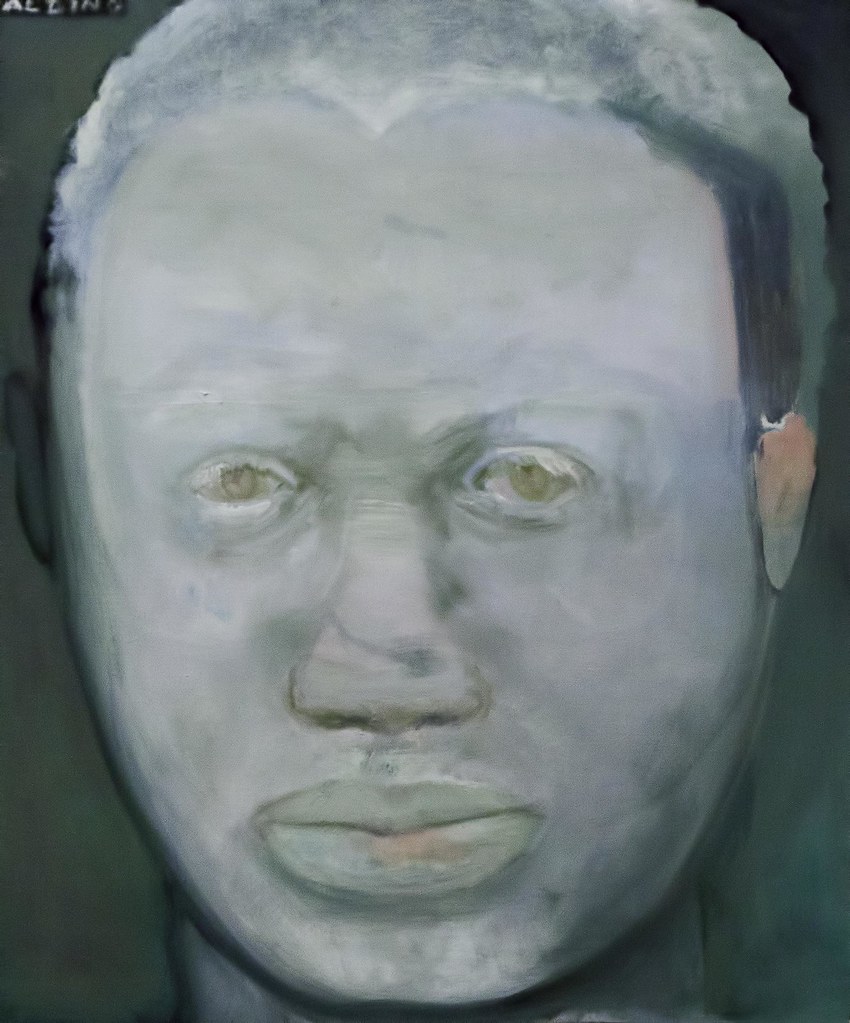
Self Portrait at Noon (7.6.22) is a portrait of the painter with her well-known curly long hair. The ghostly look of silver and black is thematic in most of her work. The sickly green reappears on the body in coordination with a set of small beady eyes set apart over a small nose and little lips showing just a hint of teeth. The black shirt offsets the light colors, adding a contrast to an otherwise monotone painting.
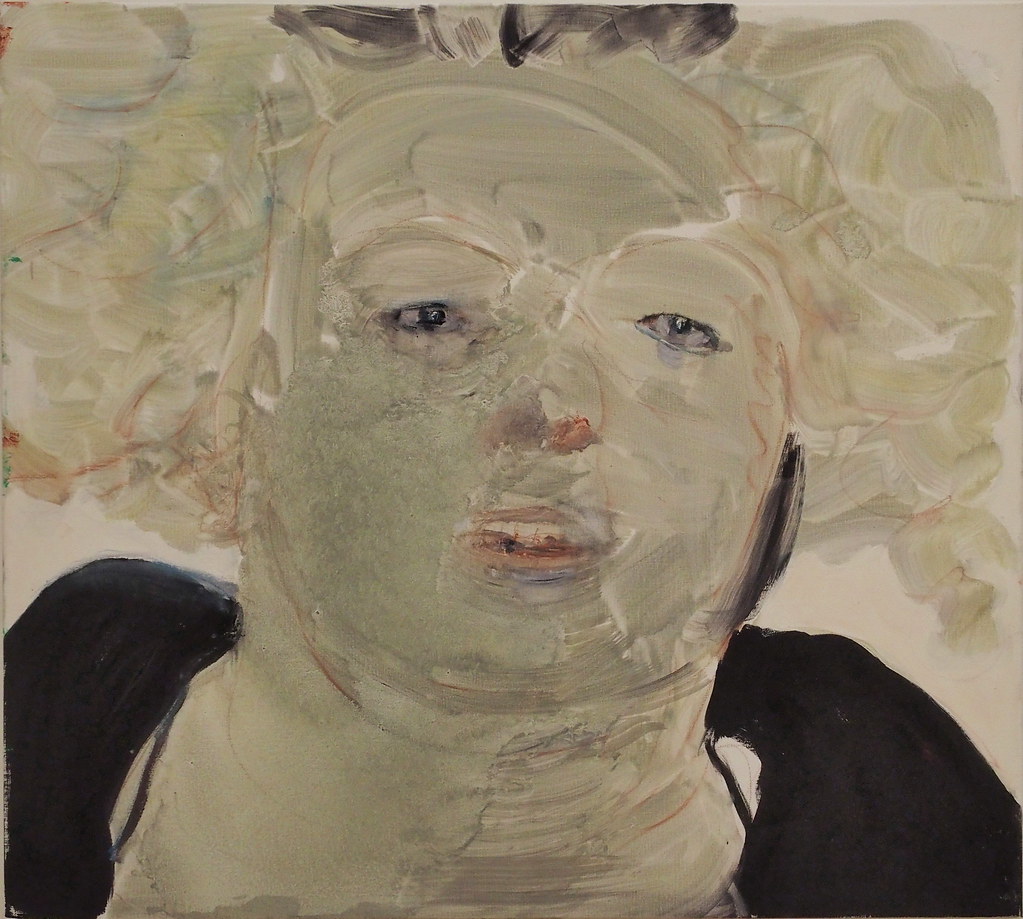
An interesting set of four paintings was created in the early 1990s called the Four Virgins (7.6.23, 7.6.24). The small figurative portraits are made from gouache and India ink and are unrecognized anonymous women. The name itself designates the virginal women, yet Dumas allows viewers to experience and make up their minds. Each portrait is similar in color and style of painting, making the group a set of black and white with blue highlights, which sets off each painting.
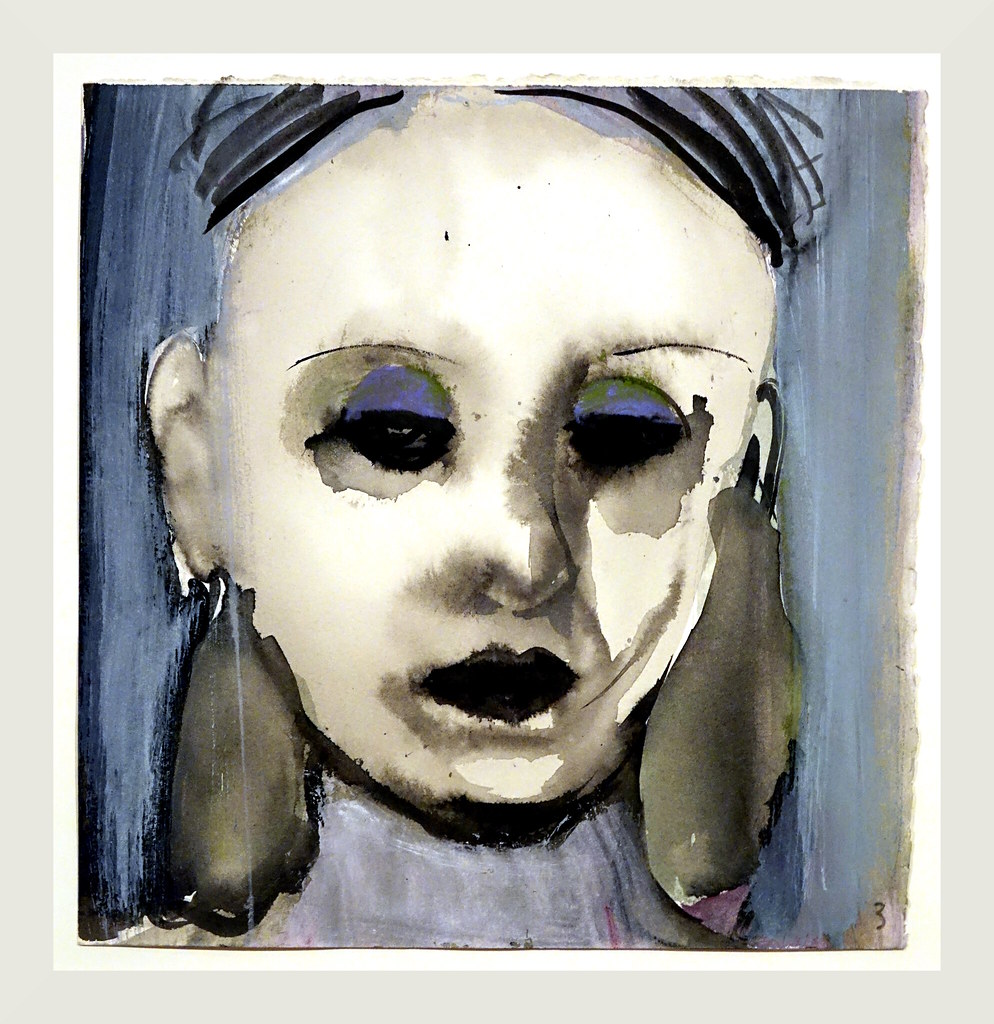
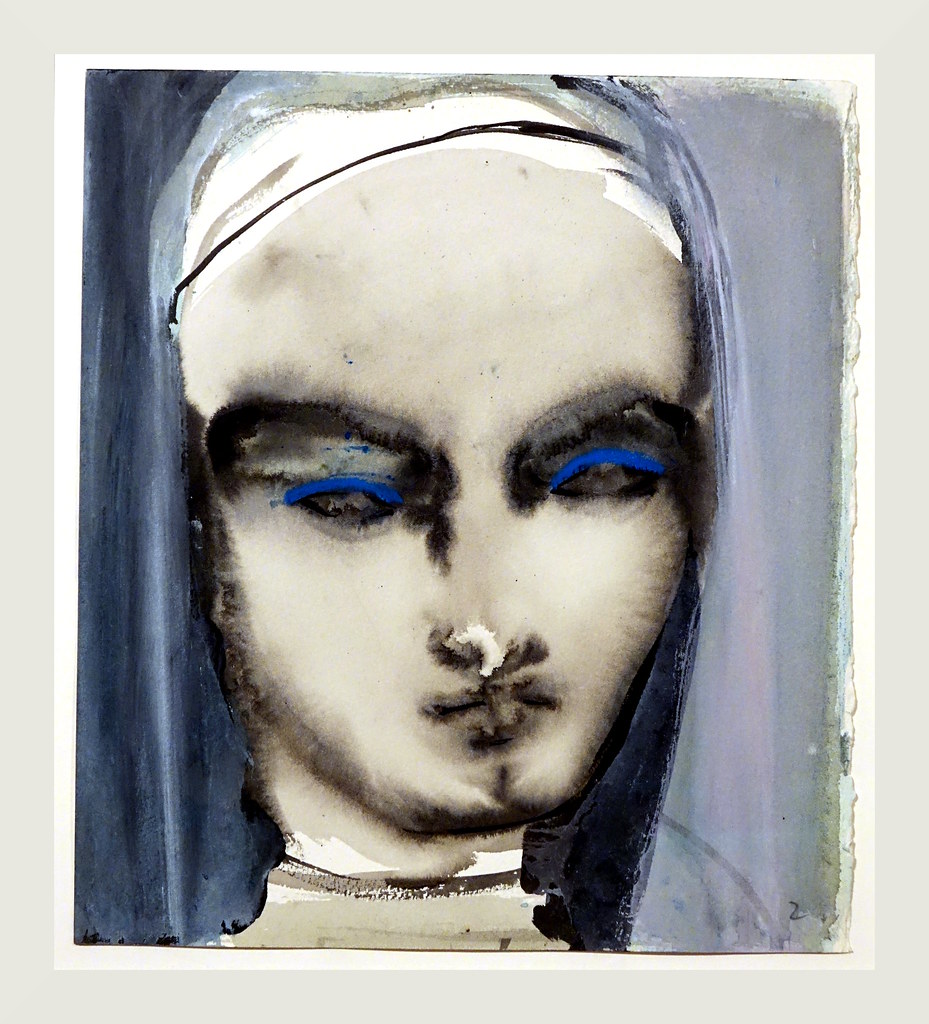
After the Four Virgins, Dumas painted a child with green hair, brooding dark eyes, with red and blue colored hands called Painter (7.6.25). Her daughter was finger painting one day with paint all over her hands and an inspiration for the concept in the painting. The baby-like body with bluish skin tones reveals the combination of abstract painterly qualities of drawing and watercolor. The figure is incomplete, a concept Dumas used to remove any real context and inaugurate a more allegorical idea.
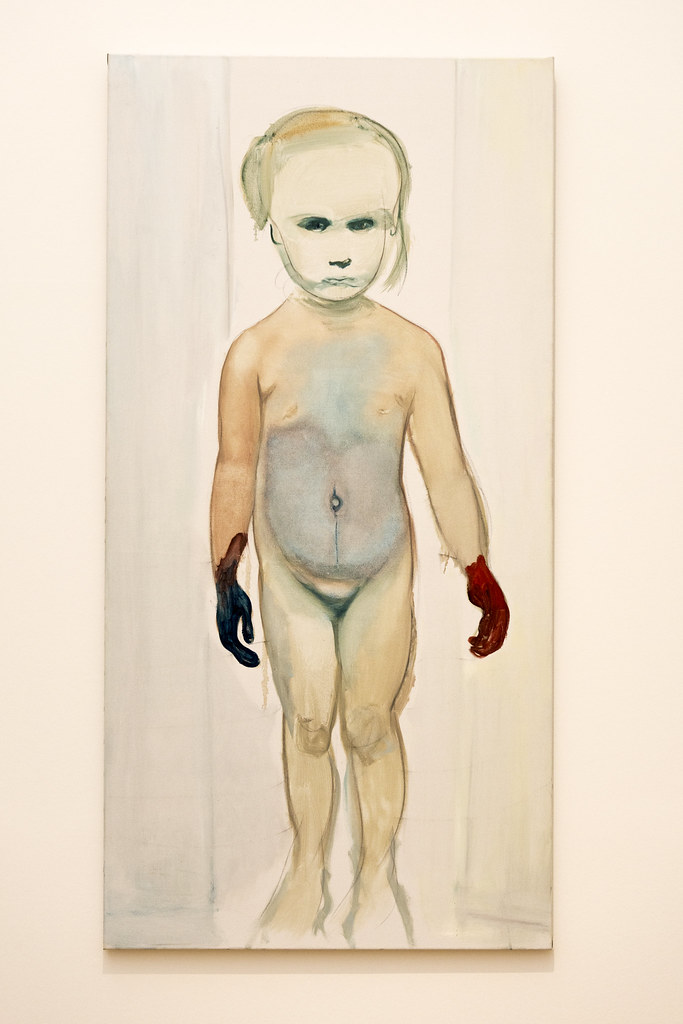
Joan Semmel
Joan Semmel (1932-) is an American feminist art painter, teacher, and writer and is well-known for her large-scale portraits. Born in New York, she earned a BFA from the Pratt Institute and then spent the next decade in Spain "gradually developing broad gestural and spatially referenced painting to compositions of a somewhat surreal figure/ground composition…(her) highly saturated brilliant color separated (her) paintings from the leading Spanish artists whose work was darker, grayer and Goyaesque".[17] After returning to the states, she earned an MFA from Pratt Institute and started her unique figurative style of erotic themes.
Once back in New York, Semmel joined the feminist movement and devoted herself to gender equality for all. Semmel paints her nudes from a perspective of a women's point of view; they undermine the male stare and reclaim female subjectivity. Nudity in art has ebbed and flowed through thousands of years and across the globe. The tradition of nudity was broken with the fading of neoclassicism art in the 19th century, and "any artist in our culture to nakedly present herself to the public is a deliberate and studied act."[18] Using herself as a model, Semmel photographs the scene she wants to paint and abstracts the images with lines and color. In Self-Made (7.6.26), Semmel combined her feminist art ideas with sexual liberation and painted the nude forms in sexual poses. The combination of two female forms in a sexual encounter is rendered with one figure in bright colors foreshortened against another in more skin tones of color. "Reclaiming the female body for women, Semmel asserted women's rights to create and control their representation and aesthetic pleasure."[19]
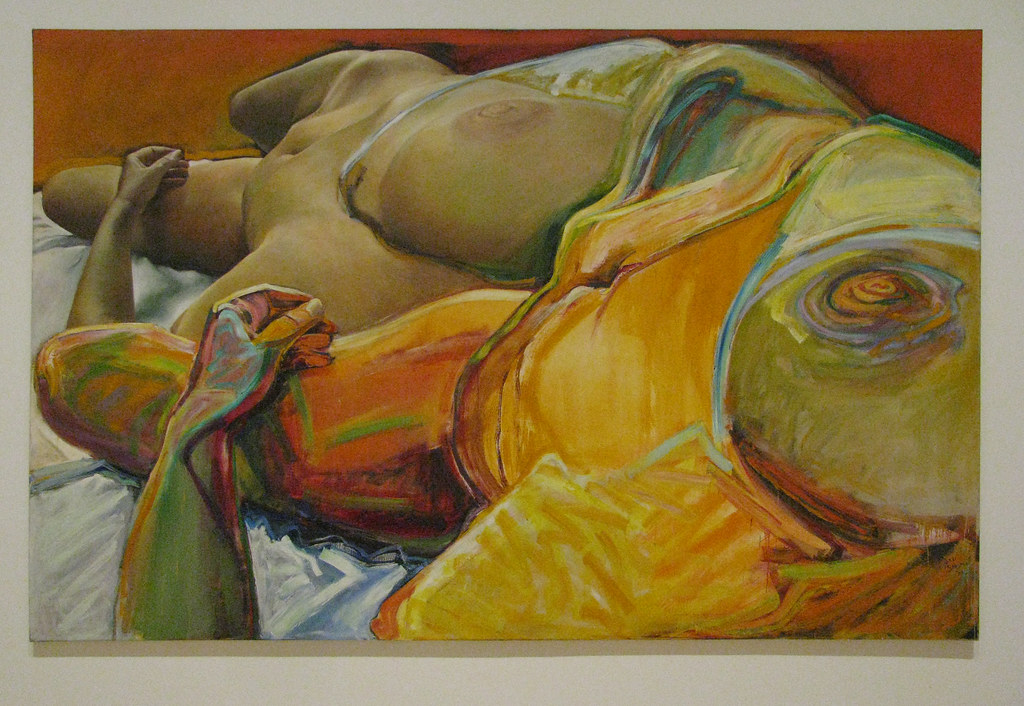
Another one of Semmel's paintings is Touch (7.6.27), from the female's perspective in the frame. Foreshortened, it is a moment of touch between two people. The erotically charged image subverts the usual position of a full-body female nude lying on a bed and provides the audience with a direct vision of the artist. The warm color tones of the two bodies contrast with the cool colors of the pillow and wall behind the couple. Semmel has continued to paint nudes into the 21st century, although her art is from the perspective of a reflection in the mirror. The paintings reflect an aging woman in a metaphysical state of exploration.
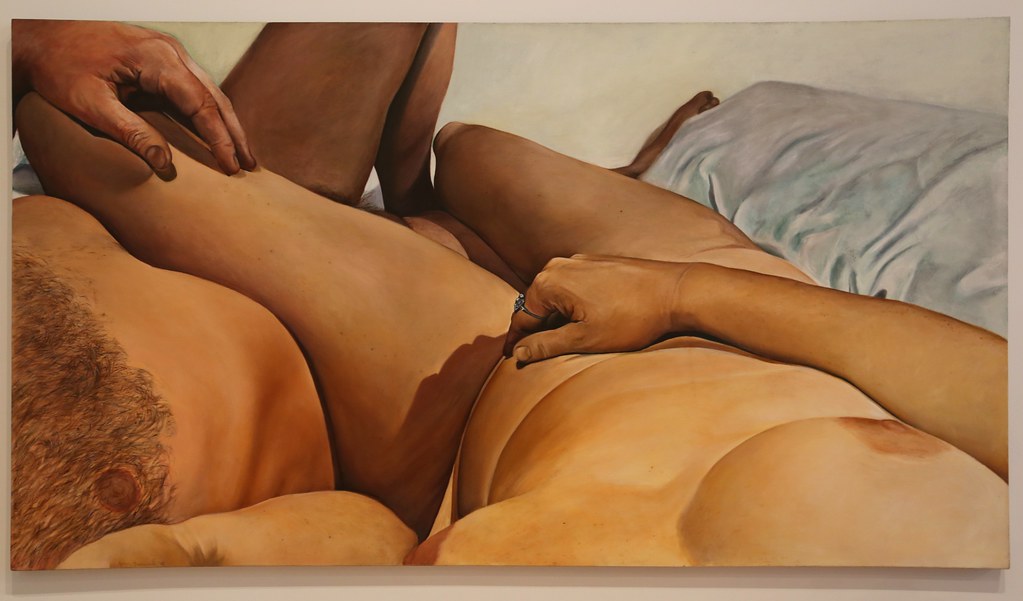 Figure \(\PageIndex{27}\): Touch (1975 oil on canvas 144 cm x 261 cm) by UGArdener, CC BY-NC 2.0
Figure \(\PageIndex{27}\): Touch (1975 oil on canvas 144 cm x 261 cm) by UGArdener, CC BY-NC 2.0Yolanda López
Yolanda López (1942-2021) is a Mexican American artist, teacher, activist, and feminist. She was born in San Diego and lived with her working-class mother and grandparents. After high school, López enrolled in San Francisco State University. She became involved in student activist groups like the Third World Liberation Front, which led to the creation of the ethnic studies college, and the Los Siete defense committee, a group supporting the men who were unjustly accused of killing a police officer (the seven men were acquitted). Through Los Siete, López designed the community newspaper ¡Basta Ya! During the period, the artist came into political consciousness.
Lopez returned to San Diego and graduated from the San Diego State University in 1975. She received a Master of Fine Arts from the University of California San Diego in 1979. During this period, she created some of her most iconic works. Her series of Guadalupe celebrated working-class Chicanas of different ages and body types. Her Guadalupe series depicted herself, her mother, and her grandmother on separate canvases. In the painting, Portrait of the Art as the Virgin of Guadalupe (7.6.28), the artist is smiling broadly with an expression of joy spread across her face. Ultimately, the image is contextualized within the feminist movement of the 1970s.
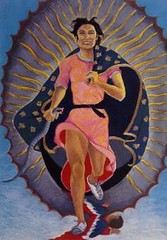
Late in her life, López was diagnosed with liver cancer, a diagnosis leading the artist to revisit her past experiences. She shared publicly that in the early 1970s, she was raped at gunpoint.[20] She was so hurt and hated the man so much she wanted to kill him; however, he later turned himself in, and she testified in court to convict the man. A viewer might wonder if the joy expressed in her self-portrait is a suggestion of her triumph over the hurt she felt from the rape. The Portrait of the Art as the Virgin of Guadalupe depicts a young, powerful feminist, Chicana, artist. Another work created simultaneously as the Guadalupe series reflected the context of immigration issues and the U.S./Mexican border conflicts in the 1970s. In print, Who's the Illegal Alien, Pilgrim? (7.6.29) the text is written on the image, and the depiction of the man underscores the artist's concern of the hypocrisy in much of the anti-immigration ideology of the time.
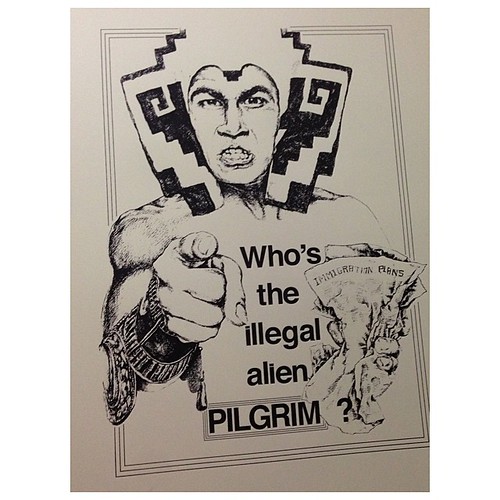
In one of her final public talks, she explained the Who's the Illegal Alien, Pilgrim? print in the following way:
…I found with a lot of men, women as well, but a lot of men really react very strongly to Who's the Illegal Alien, Pilgrim? because it is a man who's got, sort of you know, Aztec Indigenous garb but he's got an expression because a lot of times even with our imagery in the whole pantheon of our heroes whether it was Cesar Chavez or Emilio Zapata or Pancho Villa…[depictions of them] were all very stoic looking, without expression. Here I wanted to portray…expression — anger, self-righteousness, but not only that but what does he have in his hand? He has a sheaf of papers talking about immigration plans. So, it's not like a big you know AK-47 or even like with Zapata, these big sort of ancient wooden rifles and guns, but this is a man…who is talking about ideas. So that the weaponry is not necessarily our guns, but the weaponry is we have a thinking population and that I think it's part of what's appealing to men. They are presented not only with a self-expression as fierce you know as fearsome and self-possessed but also with the kind of, "this is what needs to be done…" You understand the difference and that's where I think feminism comes into that imaging of the illegal alien, that it's a thinking man…I think that's a real gift of feminism, at the time especially, looking at the representation of women in particular and transferring it over to how men are portrayed as well.[21]
We can see the foundation of López's legacy and artistic message through these two works. Even in her final years, facing her impending death, Lopez continued to urge women and Chicanas to fight for their rights, explaining that "the revolution is incremental."
Miriam Schapiro
Miriam Schapiro (1923-2015) was a Canadian feminist artist who used a variety of mediums such as paint, print, and metal to create her art. Graduating from the State University of Iowa with a Ph.D., she moved to New York City to study with the Abstract Expressionists of New York. She has been coined 'the leader of the feminist art movement' and began her abstract expressionist art career after the birth of her first son. In 1967 she moved to California, becoming the first artist who used a computer in creating art. Schapiro collaborated with Judy Chicago opening the first feminist art program and the California Institute of the Arts and the Womanhouse, an installation about women and the female experience. Schapiro started experimenting and expand the materials she used in her art and included items that marginalized domestic craft. The assemblage Barcelona Fan (7.6.30) emphasizes Schapiro's interest in fabric and the art of sewing, creating a brilliant color fan using tactile materials. The open fan is constructed with alternating rows of red and white and additions of small uses of green and blue in this bigger-than-life fan. "I wanted to validate the traditional activities of women, to connect myself to the unknown women artists…who had done the invisible 'women's work' of civilization. I wanted to acknowledge them, to honor them."[22]

In the mid-1980s, Schapiro deviated from her natural materials and created a large-scale sculpture called Anna and David (7.6.31) on Wilson Boulevard in Arlington, Virginia. The sculpture was based on a painting called Pas de Deux and is over 3.5 meters high and weighs half a metric ton. The brightly painted aluminum is a whimsical pair of dancers that conveys movement in animated poses in unabashed pleasure. The primary colors are vibrant and rich in hues giving the sculpture an animated quality. Schapiro's career spanned over four decades, creating art in abstract expressionism, minimalism, computer art, and feminist art. One type of art she created was fabric collages or, as Schapiro calls it, 'femmages’—a combination of fabric and textiles—depicting women's work.
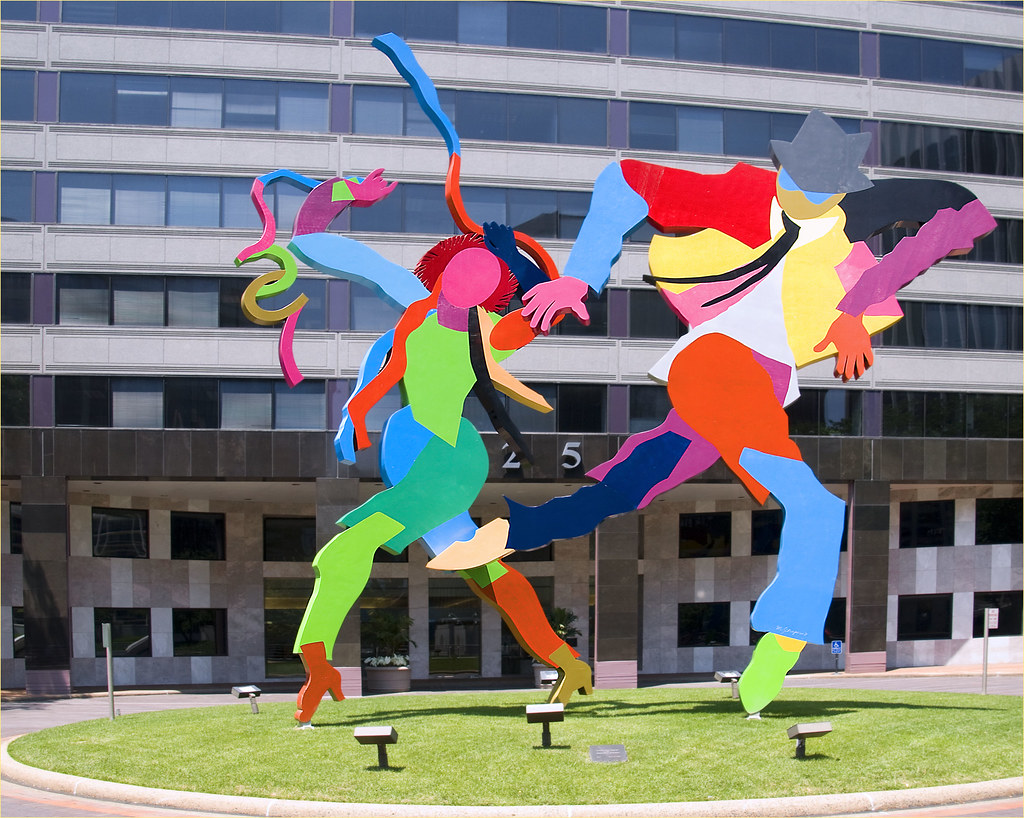
Alma López
Alma López (1966-) is a Mexican-born self-identified, Queer Chicana artist raised in Los Angeles. López holds a Bachelor of Arts from the University of California, Santa Barbara, and a Master of Fine Arts from the University of California, Irvine. She is a lecturer at the University of California Los Angeles in the Department of Chicana/o Studies. López works in various mediums as a painter, printmaker, photographer, digital and video artist. Much like feminist Chicana artists before her, she reinterprets traditional imagery of historical, cultural, and religious figures such as the Virgin of Guadalupe in work titled, Our Lady (7.6.32).
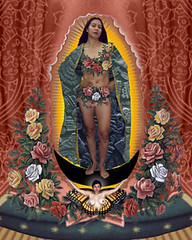
Though controversial, as the artist explains, "Catholic or not, Chicana/Latina/Hispana visual, literacy, or performance artists grew up with the image of the La Virgen de Guadalupe, therefore, entitling us to express our relationship to her in any which way relevant to our own experiences. Many artists, such as Yolanda M. López, Ester Hernández, Santa Barraza, Delilah Montoya, Yreina D. Cervantez, and Raquel Salinas, have shared their own personal experiences using La Virgen de Guadalupe.”[23]
Additionally, "López claims that her image was meant to be empowering—a feminist statement and a declaration of indigenous pride…More than a religious symbol, the image-maker says she saw the icon as an artistic one—a public fixture whose roots are more cultural than spiritual 'So for me, she represented culture, community, and family.'"[24] Her feminism extended to Indigenous subjects. In her works of art, the imagery recalls the Aztec world by incorporating references to Aztec deities and other prominent symbols of Mexico. She incorporated themes of immigration, specifically through the imagery of the Monarch butterfly, which yearly travels unimpeded between Mexico and Canada.
From a 2014 exhibition, The Power of Movement, we see the theme of feminism, immigration, and self. The image on the left, My Bad (7.6.33), depicts a self-portrait of the artist, including a halo of roses as if she has tossed them above her head and a monarch butterfly. On the right side of the photograph is a series of six panels, entitled Virgen/Lady (7.6.33). The traditional iconography of Guadalupe is juxtaposed alongside painted images of her own reinterpreted version, Our Lady (7.6.33). In the traditional reference of Guadalupe, her head is bowed in a subservient posture (with text overlay, "Revolution is guided by great love"). In the reinterpreted image, the face of her model, Raquel Salinas from Our Lady, stares straight out at the viewer. "Raquel Salinas's pose and eyes in Our Lady epitomized the feminist return of the gaze that challenges the physical and discursive control over women's bodies, defying the containment of female agency within gendered objectifications" [25] The gaze here is a painted representation based on the original artwork.
The traditional reference shows hands clasped in prayer in front of a fully clothed body. In contrast, Lopez's painted reinterpretation depicts female hands with pink painted fingernails confidently placed on her hips, her midriff exposed. Some versions include an overlay of the outline of Coyolxauhqui (based on an Aztec sculpture of the goddess). Finally, the traditional iconography of the angel with eagle wings is on the traditional reference. The reinterpreted image depicts a bare-breasted woman with a monarch butterfly wing behind her. López's reinterpreted painted, and deconstructed image challenged the traditional image by juxtaposing three specific iconographic changes the artist made in her reinterpreted image.

Shirin Neshat
Shirin Neshat (1957-) is an Iranian-born artist who fled the Iranian Revolution in 1979 and moved to the United States at seventeen. She graduated with an MFA from the University of California, Berkeley, moved to New York City, and worked at an independent gallery. Returning to Iran for the first time in 1990, Neshat was shocked by the social and political upheaval caused by the war. Returning to the states, she dove back into her art, mixing Farsi text with photographs based on her experience in Iran. The text is from female authors during the revolution, such as poet Tahereh Saffarzadeh (1935-2008).[26]
Neshat's early photographic work addressed the women's psychological experience in Islamic cultures. Exposing the issues of femininity and how women identify themselves, she captures the concepts of polemical essays. Speechless (7.6.34) is one of a group of formidable images Neshat has connected to Islamic fundamentalism. During her return to Iran, she faced a changing country, men had taken control, and the once cosmopolitan women no longer existed. Staging photographs of women in chador dressings staring right at the viewer and holding guns with text on their faces were powerful pieces of art. The print Speechless is a close-up on a women's face with the barrel of a gun in place of an earring. The women do not appear weak; instead, Neshat has portrayed them as strong and heroic despite suffering through years of social persecution.

Neshat created a series entitled The Villains (7.6.35), pictures of older men with calligraphic details across their chest and arms. The text represents metaphors from the Book of Kings—a Hebrew Bible written in two books. In Bahram, the scene depicts the king on a horse leading an army of men carrying a flag across the plains into battle. "Shirin's exhibit was motivated by the series of political uprisings, now commonly known as the Arab Spring, which took place throughout different Arab countries between 2011 and 2012. The Book of Kings explored the causal conditions of power within social and cultural structures in the modern society."[27]

The paradigm shift in museums has started. Thanks to countless women artists during the last three decades of the 20th century, more women are represented in museums and galleries than nude women hanging on the walls. Without these feminist artists, the door opening for generations of young girls would not be open. The feminist artist gave a fresh and realistic perspective about the female body and art and rewrote art history at the same time. Post-modernism questioned everything about our society and the cultural changes which needed to be addressed. The men who wrote art history left women out of their books; why? Simply because they are women.
[1] Freedman, E. (2001). No turning back: The history of feminism and the future of women. New York, NY: Ballantine Books. (p. 5).
[2] Freedman, E. (2001). No turning back: The history of feminism and the future of women. New York, NY: Ballantine Books. (p. 319).
[3] Nochlin, L. (2015). Female artists. New York, NY: Thames & Hudson.
[4] Nochlin, L. (2015). Female artists. New York, NY: Thames & Hudson.
[5] Doss. E. (2002). Twentieth-Century American Art. Oxford. (p. 184).
[6]Retrieved from: https://www.riseart.com/guide/2418/g...t-art-movement
[7] Retrieved from: https://www.moma.org/collection/works/196031
[8] Clark, R. (2001). Carolee Schneemann’s rage against the male. The Guardian. Retrieved from https://www.theguardian.com/artandde....artsfeatures1
[9] Ibid.
[10] McKenzie, L. (2018). "Jenny Holzer, the feminist artist behind Lorde's Grammys gown message, isn't a stranger to the fashion world". Los Angeles Times. (10)
[11] Retrieved from: https://www.brooklynmuseum.org/opencollection/objects/211047
[12] Doss. E. (2002). Twentieth-Century American Art. Oxford. (p. 198).
[13] Retrieved from https://philamuseum.org/collection/object/86892
[14] Ramos, E. Carmen (2014). Our America. Smithsonian American Art Museum, Washington, DC.
[15] Taylor, R. (2010). Lorna Simpson exhibition catalog at the Tate. Retreived from: https://www.tate.org.uk/art/artworks/simpson-five-day-forecast-t13335
[16] Retrieved from: https://www.artic.edu/artworks/160222/albino
[17] Semmel, J. (2015). Joan Semmel: Across Five Decades. Alexander Gray Assoc., LLC.
[18] Semmel, J., Modersohn-Becker, P., Antin, E., & Withers, J. (1983). Musing about the Muse. Feminist Studies, 9(1), 27–32. https://doi.org/10.2307/3177681
[19] Doss. E. (2002). Twentieth-Century American Art. Oxford. (p. 184).
[20] López, Y. “Thought, Art, and Social Practice Presents: A tribute to Yolanda M. López, Artist Provocateur. An interview by Cherríe Moraga and Celia Herrera Rodriguez. February 12, 2020.
[21] López, Y. “Thought, Art, and Social Practice Presents: A tribute to Yolanda M. López, Artist Provocateur. An interview by Cherríe Moraga and Celia Herrera Rodriguez. February 12, 2020.
[22] Doss. E. (2002). Twentieth-Century American Art. Oxford. (p. 187).
[23] De Alba, G., Lopez, A., Lopez, A., Ed. (2011). Our Lady of Controversy, Alma López’s Irreverent Apparition, University of Texas Press.
[24] Retrieved from https://www.sfreporter.com/arts/artsvalve/2013/07/02/shame-as-it-ever-was/.
[25] Herrera-Sobek, María, et al. “Digital Art, Chicana Feminism, and Mexican Iconography: Visual Narrative by Alma Lopez in Naples, Italy .” Chicana/Latina Studies , vol. 6, no. 2, 2007, pp. 68–91, https://doi.org/https://www.jstor.or...able/i23013190.
[26] Phaidon Authors. (2019). Great women artists. Phaidon Press. (p. 298).
[27] Retrieved from: https://publicdelivery.org/shirin-ne...book-of-kings/


